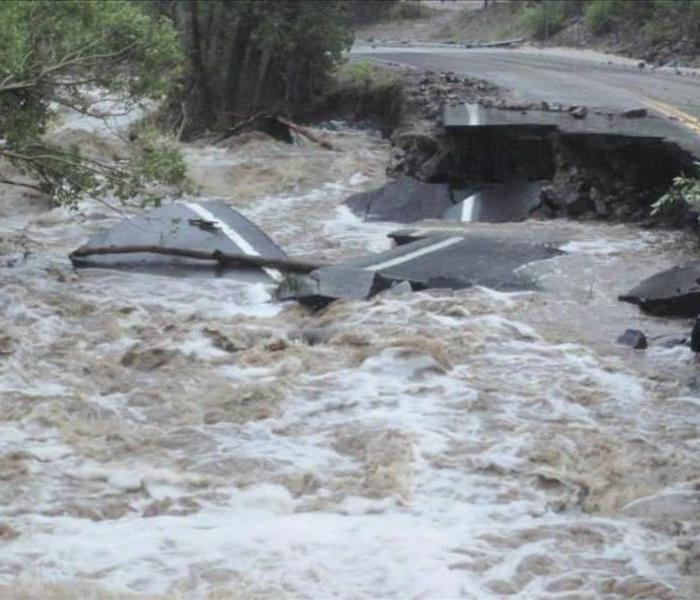How to survive a Flood
10/19/2016 (Permalink)
Floods are the number one natural disaster in the United States, and when looking at the 30-year average, they are the number one cause of weather-related fatality with an average of 81 deaths per year.
To put it simply, it’s easy to underestimate the power of water. In a flash flood, six inches of moving water is enough to knock a person over; 12 inches of moving water can sweep away a small car. Both moving and rising water demand respect!
Few places are immune to floods, wherever it rains, flooding can occur. And many of us TreeHugger types are known to live nearby or spend time in areas that are especially prone to flooding. So with that in mind, here are some pointers to help keep you safe when a great deluge decided to do its thing.
Turn around don’t drown!
The National Oceanic and Atmospheric Administration (NOAA) came up with the phrase "Turn around don’t drown" (and then registered it as a trademark) to further the National Weather Service’s (NWS) mission to help save lives. As it turns out, the CDC reports that half of all flood drownings happen when a vehicle is driven into hazardous floodwater. As mentioned above, 12 inches of moving water can take a small car; two feet will sweep away a larger vehicle. People think they can pass a puddle in the road, only to have their car stall and then ... whoosh. Turn around, don't drown!
Flash floods 101
This may sound obvious, but apparently it’s not the first thing that comes to mind for many. If there is a chance of flash flooding, move to higher ground as quickly as possible. If you’re in your car and water rises around it, leave the car and seek higher ground. (If the water is moving, however, do not leave the car.)
The NWS notes that a creek only six inches deep in mountainous areas can swell to a 10-foot deep raging river in less than an hour if a thunderstorm produces intense rainfall. During heavy rainfall or in times of flood watches or warnings, do not camp or park near streams, creeks or rivers.
Stay tuned in
During thunderstorms, heavy rainfall or other inclement weather, stay tuned to local television or radio for weather updates and emergency instructions. Here are what the alerts mean:
Flood Watch: Flooding is possible.
Flash Flood Watch: Flash flooding is possible; be prepared to move to higher ground.
Flood Warning: Flooding is occurring or will occur soon; if advised to evacuate, do so immediately.
Flash Flood Warning: A flash flood is occurring; seek higher ground on foot immediately.
Know your elevations
In the same way flight attendants point our emergency exit doors, you should familiarize yourself with high points in your area (whether ground or buildings) and especially know those that are accessible by foot.
Prepare your home
Outdoor furniture can be moved inside and important items can be moved to the highest point in your home. Electrical appliances should be unplugged (but only when you are dry and not standing in water). You may be instructed to turn off your gas and electricity at the main switch or valve, which can help to prevent fires and explosions.
Protect your pets
Never leave your pet home alone when there is a flood warning, even if your home is not directly threatened. Roads may be closed or your home may become otherwise inaccessible, leaving your pet stranded. Also, never leave a pet leashed or caged during a flood warning; the reason there is obvious, right?
Also be extra careful with pets if your area is directly flooding. If it takes just six inches of water to whisk an adult away, it takes much less to take a pet.
After a flood:
- Return home only when authorities say it is ok.
- Watch out for debris where water has receded.
- Before entering your home, look outside for loose power lines, damaged gas lines, foundation cracks or other damage.
- If you smell natural or propane gas or hear a hissing noise, leave quickly and call the fire department.
- Check for creatures that may have taken refuge or been washed inside your home; snakes, in particular, are prone to displacement. Especially check before you let pets re-enter.
- If your property has been flooded, allow your pets to reorient when you return. Flooding can wash away scents and may have destroyed landmarks your pet uses to keep track of locations. Without those, getting lost is more likely. Walk your dog with a leash for a few days until she/he is readjusted.
- Be cautious with paths and roadways, as they are often eroded and compromised by floodwater.
- Avoid standing water as there may be risk of electrocution from underground or downed power lines.
- Contact your local or state public health department for specific advice for boiling or treating water where you are after a disaster as water may be tainted.
- Let your family know you’re safe.
- And while it may be the last thing on your mind, remember to photograph damage to your property for insurance purposes.
info provided by: http://www.treehugger.com/green-home/how-survive-flood.html





 24/7 Emergency Service
24/7 Emergency Service